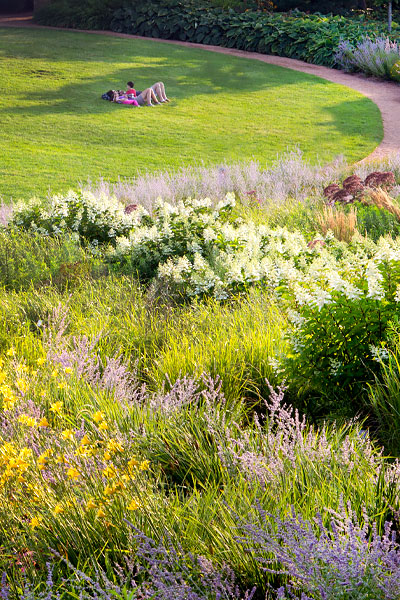Sit-spots are pretty much what they sound like—a place outside where you can sit and reflect. We use them often with little ones in the Chicago Botanic Garden’s Nature Preschool.
The dedicated places are a mindful way for people of any age to check in with and be present in the natural world.
Choosing a Spot

The best kind of sit-spot is one that you feel comfortable in and familiar with. So choose a natural area that is easily accessible and preferably in a location that you can visit regularly. That might mean a spot in your yard, a schoolyard, a public park, an open grassy area, or a patch of prairie or woods in your neighborhood. Just make sure it’s a place where natural features catch your eye—trees, rocks, grasses, shrubs, water, plants, flowers, and maybe a view.
You can lean against a tree or sit on a rock. Or cut up an old yoga mat or tarp and sit on the ground. You can even use an old towel or jacket. You can have a family sit-spot or one that’s just for you.
How to Settle into Your Sit-Spot
Try to visit your sit-spot once a week. Start with a five-minute visit and build from there. After you turn off your phone and get settled, take three deep breaths. Breathe in through your nose and out through your mouth. To give kids a visual cue on how to do this, pretend to smell a flower and then blow out birthday candles. Then repeat the phrase: “Smell your flower; blow out your candle!” If you’re by yourself, you might want to simply close your eyes and breathe deeply for a few minutes.
Other Sit-Spot Ideas and Activities to Explore

- Close your eyes and meditate or repeat mantras.
- Run through a sensory checklist: Note the smell, touch, sight, sound, and even taste of what’s nearby, if it’s safe to do so.
- Take time for wildlife:
⇒ Sprinkle bird seed near your sit-spot or hang a bird feeder. Note the different birds you see as the seasons change.
⇒ Use a magnifying glass to look for insects on the ground. - Write in a journal. Draw in a sketchbook. Try sound mapping: Draw an “X” to represent you in the center of your page. Then write or draw what you hear around you, in relation to your position.

